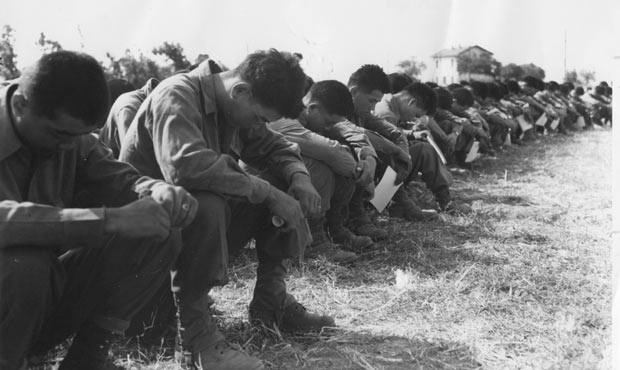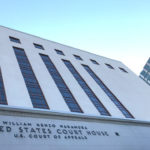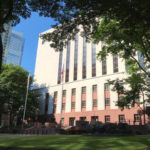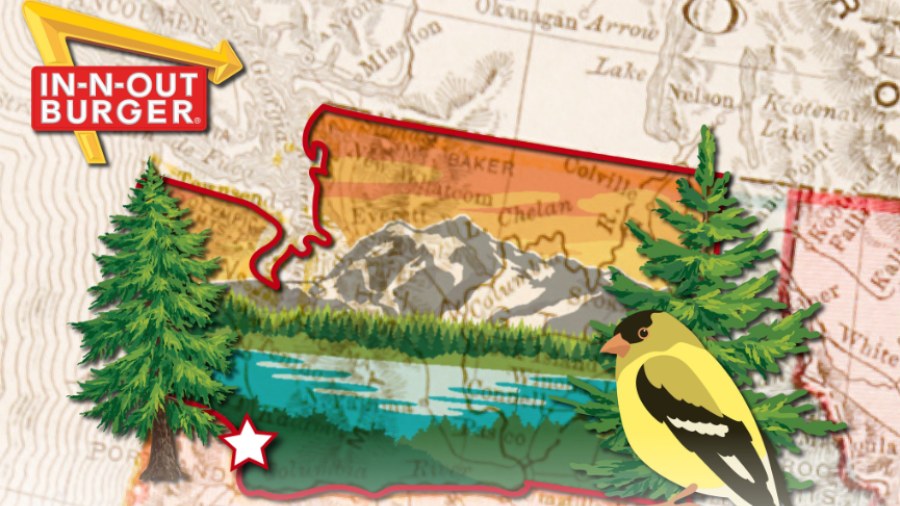Seattle’s Japanese-American war hero who died on the 4th of July
Jul 3, 2019, 6:47 AM | Updated: 8:51 am
This Fourth of July will mark the 75th anniversary of the battlefield death of Pfc. William Kenzo Nakamura of Seattle. He was just 22 years old when he lost his life to a German sniper in Italy.
More than a half-century later, as part of a federal review in the 1990s of Japanese-American World War II Distinguished Cross Recipients, Nakamura was ultimately awarded this nation’s highest citation for bravery, the Medal of Honor.
Nakamura was a member of the 442nd Regimental Combat Team, a segregated US Army unit during World War II made up of Japanese-Americans. A film made by the US Army during the war described the soldiers and the origins of their distinctive motto:
Many of them volunteered to fight when they were behind the barbed wire enclosures of relocation centers, where they had been moved in 1942 soon after the outbreak of war. They volunteered to fight for the land of their birth, the adopted land of their parents. The Hawaiian boys gave the combat team a motto: go for broke. It’s a gambler’s term. It means shoot the works, go all out, do or die. Go for broke.
William Kenzo Nakamura, who went by Bill in the neighborhood and Kenzo at home — which means strong and healthy — was born in Seattle in 1922 in Japantown, a part of what’s now the International District. He went to Washington Middle School and graduated from Garfield High School, and he was attending the UW when the US entered World War II after the Japanese attack on Pearl Harbor.
Nakamura and his brother George were both born in the United States; his parents had immigrated to the US from Japan. He was incarcerated at Minidoka in Hunt, Idaho beginning in 1942 with his two sisters, father and brother. They were among more than 110,000 Japanese-Americans from Hawaii and the Pacific Coast, who were spread among a series of other camps throughout the Mountain West.
In 1943, Bill and his brother joined the US Army voluntarily, and became part of the 442nd Regimental Combat Team. They went to basic training in Mississippi, and then to Europe to fight the Nazis. Bill’s unit was trying to capture a hill from the Nazis in Italy on July 4, 1944.
On D-Day, West Coast radio listeners ‘sat up all night by the radio’
One Seattle family’s incredible World War II homefront hospitality
Steve Finley of Bellevue knows Bill Nakamura’s story by heart.
“It was on July 4, 1944 in a battle near Castellina, Italy, he saved the lives of his entire platoon twice in one day,” Finley said, “And he was killed. He was originally awarded the Distinguished Service Cross, which was the second highest award for bravery.”
The official citation for Nakamura’s Medal of Honor reads, in part:
During a fierce firefight, Private First Class Nakamura’s platoon became pinned down by enemy machine gun fire from a concealed position. On his own initiative, Private First Class Nakamura crawled 20 yards toward the hostile nest with fire from the enemy machine gun barely missing him. Reaching a point 15 yards from the position, he quickly raised himself to a kneeling position and threw four hand grenades, killing or wounding at least three of the enemy soldiers. The enemy weapon silenced, Private First Class Nakamura crawled back to his platoon, which was able to continue its advance as a result of his courageous action. Later, his company was ordered to withdraw from the crest of a hill so that a mortar barrage could be placed on the ridge. On his own initiative, Private First Class Nakamura remained in position to cover his comrades’ withdrawal. While moving toward the safety of a wooded draw, his platoon became pinned down by deadly machine gun fire. Crawling to a point from which he could fire on the enemy position, Private First Class Nakamura quickly and accurately fired his weapon to pin down the enemy machine gunners. His platoon was then able to withdraw to safety without further casualties. Private First Class Nakamura was killed during this heroic stand. Private First Class Nakamura’s extraordinary heroism and devotion to duty are in keeping with the highest traditions of military service and reflect great credit on him, his unit, and the United States Army.
Inspired by Nakamura
Nearly 20 years ago, Steve Finley was inspired by Nakamura’s story, and the posthumous award of Nakamura’s Medal of Honor, to do something about helping the community remember the local man and his long-ago heroism.
Finley is a retired political consultant. He previously worked for former Governor Mike Lowry when he was a Congress member. He had friends who were part of a local Japanese-American group called the Nisei Veterans Committee, and he’s always been grateful to a number of Japanese-Americans neighbors in the community where he grew up in Utah. He speaks fondly of a doctor who treated his terminally ill mother, and of a farmer who give the young Finley his first job.
First and nearly forgotten Independence Day celebration in Washington
D-Day is personal for many observing the 75th anniversary
The idea to name a building in Seattle after William Nakamura came to Finley after he read a particularly poignant newspaper story on Memorial Day Weekend 2000.
“There was an article in the Seattle Times by Alex Tizon about Nakamura when he was awarded the Medal of Honor,” Finley said. “Towards the end of the article, it might have been the last paragraph, his sister [June Oshima] said, ‘Well, Seattle’s forgotten my brother, I hope they will remember him.’”
Thanks to Steve Finley, Seattle has not forgotten William Nakamura. At least, not completely.
Finley’s political background came in handy almost right away when he decided the smoothest route to permanently honoring Nakamura would be to find a building that wasn’t already named for someone else. That’s how he came across the 1940 federal courthouse on 5th Avenue in downtown Seattle, which has its own distinctive history of momentous trials and verdicts.
With the courthouse in his sights, Finley got to work doing what he does best.
With help from community leader George Yamane, the two sought official resolutions of support the Seattle City Council and other jurisdictions during the summer of 2000. Then, that autumn, they arranged for US Representative Jim McDermott, US Senator Patty Murray and US Senator Slade Gorton to help sponsor bills in their respective chambers of Congress.
Incredibly, by early November 2000 – just few months after Finley and Yamane began their effort – the United States House and United States Senate both voted unanimously to pass the legislation and officially name the courthouse for William Nakamura. President Clinton signed it into law.
The pace of Finely and Yamane’s efforts were quick by any standards, but they were just plain lighting-fast when it comes to pulling the levers of democracy at the local and federal level.
The naming ceremony took place in March 2001; another ceremony was held in 2009 after the courthouse underwent a major renovation.
An American story
Though the honored soldier’s widow, sister and other immediate family members have since passed away, Steve Finley isn’t the only one who knows about William Nakamura’s story.
Mitchell Maki is executive director of an organization in California devoted to the history of Japanese-American military service in World War II called the Go For Broke National Education Center.
Maki says that the notion of incarcerated young Japanese American men voluntarily joining the US military was a mixed blessing, and caused personal turmoil to families already being held in camps.
“It literally tore families and extended families apart,” Mitchell said. “As half the family would say, ‘Hell no, you’re not gonna go. You’re not gonna go and possibly die fighting for a country that has put us behind barbed wire.’ And then on the other side, there’d be people saying, ‘But if you don’t go, you’re just proving that we are the enemy. You’ve got to go and prove that we’re loyal Americans.’”
And Mitchell Maki says they really did prove it. In spite of facing discrimination at home and in the military overseas, the 442 Regiment is considered the most decorated unit in World War II.
Maki also says that young Japanese American men like Nakamura knew they were being tested, and knew they were considered expendable. Maki has spoken with 442nd vets who told him it felt like the soldiers were fighting two battles: one against the Nazis in Europe, and the other against discrimination at home.
Maki says that for Independence Day, it’s important to thank all veterans for their service, and to always remember the bravery and sacrifice of Seattle-born William Kenzo Nakamura.
“His story is the quintessential Japanese American veteran’s story of World War II,” Maki said. “He was a young man who the family and himself were denied their Constitutional rights. They were judged by the color of their skin and their nation of origin. He was the son of immigrants who then decided to serve our nation and make the supreme sacrifice by serving the nation by giving his life.”
“It’s really not a great Japanese American story,” Maki said. “It’s a great American story.”
William Kenzo Nakamura is buried at the Veterans Memorial Cemetery at Evergreen-Washelli in North Seattle.
Special thanks to Lee Corbin and Frank Abe for their assistance with this story.






















